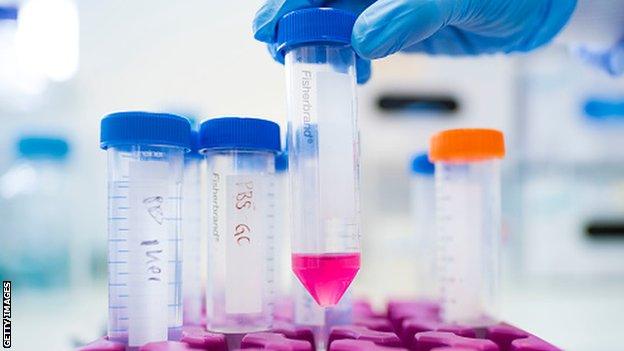Trans female athletes must lower testosterone levels, IAAF rules
- Published

The new rules were announced after a meeting of the IAAF Council in Doha
Trans female athletes must lower their levels of testosterone, athletics' governing body the IAAF has ruled.
Competitors must now keep their levels of natural testosterone below five nanomoles per litre of blood in order to compete in the female category.
The IAAF's previous limit for natural testosterone was 10 nanomoles.
The new regulation is the same as that which applies to athletes with differences of sexual development (DSD), including Caster Semenya.
Semenya is challenging the IAAF's new rules that she and other athletes with DSD must take testosterone-reducing medication in order to compete in track events from 400m to the mile or change to another distance.
The new rules on natural testosterone levels were announced on Monday following a meeting of the IAAF Council in Doha.
Under the new regulations a transgender female athlete is no longer required to be recognised by law in her new gender but should provide a signed declaration that her gender identity is female.
She must demonstrate that the testosterone level in her serum has been less than five nanomoles continuously for a period of at least 12 months prior to being declared eligible, and must keep below that level to maintain eligibility to compete in the female category.
Analysis
Ben Hunte, BBC LGBT correspondent:
Whilst it could be said that most people support the long-held practice of separate male and female categories in sporting events, defining who exactly belongs to those two categories is now creating a huge ongoing debate.
Many areas of society now see gender as wider than the traditional binaries of 'born male' and 'born female', yet official bodies in a variety of sectors are struggling to adjust - should they want to.
From physical examinations to genetic testing, this ruling is the latest in attempting to regulate the bodies of transgender individuals. Some hugely celebrated cisgender female (female born) athletes say it's for a good reason. Many have continually flagged their concerns about transgender athletes competing in their sports, such as Martina Navratilova and Sharron Davies, namely around unfair physical advantages.
However, LGBT activists warn that this new method by the IAAF is fear-mongering. With trans people making up less than 1% of the population, they point out that there are not even enough known transgender athletes competing at the IAAF level to warrant this level of debate.
How many elite-level transgender athletes can you name?